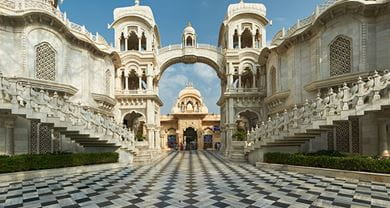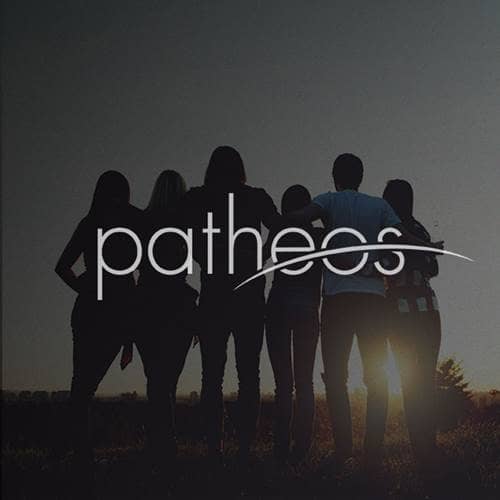- Trending:
- Pope Leo Xiv
- |
- Israel
- |
- Trump
- |
- Social Justice
- |
- Peace
- |
- Love

RELIGION LIBRARY
ISKCON (Hare Krishna)
Community Organization
ISKCON's community organization is best understood as a series of concentric circles, with the temple at the absolute center. Radiating out from the temple with increasing metaphoric distance are full-time residents of temples, ISKCON-initiated congregational members, non-initiated congregational members, and frequent visitors.
Though ISKCON's temples undoubtedly serve as ceremonial and ritual centers for the movement, they also function as the center of community organization. With few exceptions, members of the International Society for Krishna Consciousness live within easy driving distance of a temple, and have chosen to do so intentionally. The movement operates over three hundred temples, spread over every continent except Antarctica, and in most major cities around the globe. It also operates several dozen farming communities and rural communes, which generally function as temple equivalents for purposes of community organization.
In addition to their unmistakable place at the heart of ISKCON's deity worship ceremonies, temples host reading groups, lectures, workshops, and presentations on issues pertinent to Krishna Consciousness. Often they host regular weekly community programs. The most common such programs are lectures, discussions, and classes on the sacred texts of Gaudiya Vaishnavism, notably the Bhagavadgita and Bhagavata Purana. Classes always use the translations and commentaries prepared by founder A.C. Bhaktivedanta Prabhupada, which ISKCON devotees consider more reliable and accessible than all other translations. In some cases classes take the form of lectures by gurus (spiritual teachers), and in other cases leading members of the community offer the classes. Depending on the style of the teacher and the norms of a particular temple, sessions might also take the form of discussion. In the United States, temples also host programs on Krishna Conscious parenting, finance, and other topics of relevance to the mostly-congregational members of the community.
The Hare Krishna devotees who live in temple communities serve as the metaphoric center of ISKCON communities. Such individuals are always initiated devotees who have vowed to obey ISKCON's regulatory principles and engage in acts of religious devotion to Krishna. They generally fall into one of two categories: celibate students (brahmacharis [male] or bramacharinis [female]), or celibate renunciates (sannyasis). Sannyasis, or monks, serve as the highest leaders of ISKCON, both of individual communities and the broader movement. They are the spiritual teachers, or gurus, who offer instruction on Krishna Consciousness, initiate new devotees, and in many cases make the central decisions for the organization. In keeping with the Bengali Hindu norms with which Bhaktivedanta was familiar, all sannyasis are male. In the early days of ISKCON, most males endeavored to become sannyasis, and often did so after only a few years in the movement. Many, however, proved unable to maintain their vows and fell from their positions. Today, the sannyasi role is reserved for fewer individuals with longer histories in the movement who understand the ramifications of a life-long vow of celibacy and religious devotion.
Despite their title, brahmachari and brahmacharini students need not be young people, and in many cases older devotees who chose not to marry remain as brahmacharis or brahmacharinis throughout their life. These individuals serve as ritual priests, performing the artis, leading deity worship, and cooking the prasadam for the temples, as well as serve support roles at the temple, such as clerical and ground keeping duties. Such students also generally serve as missionaries, attempting to spread Krishna Consciousness through public worship and preaching (sankirtan). Like sannyasis, brahmacharis and brahmacharinis live in temples in accordance with strict rules of behavior and discipline, though in exceptional cases of temple crowding brahmacharis sometimes live in satellite locations.
In order to operate, the temples rely on the volunteer time and resources of their many congregational members. The next metaphoric circle of ISKCON membership, congregational members generally live within easy commuting of temples, but work and live outside their confines. Congregational members are generally initiated Hare Krishna devotees. Like the sannyasis, brahmacharis, and brahmacharinis, such individuals have vowed to live in accordance with the movement's regulatory principles and engage in acts of devotion to Krishna. ISKCON experienced a radical transformation during the 1980s and 1990s when many of its members transitioned from living full-time in the temples to becoming such congregational members. Because congregational members hold outside jobs, their financial contributions are important to ISKCON temples.
Most congregational members are also married with families. As ISKCON understands it, in choosing to marry and have families these devotees have moved into a different state of life, that of householder (grihastha). In this regard, ISKCON has followed normative Hinduism in its acceptance of the four ashramas, or stages of life, which progress from student to householder to retiree to monastic. Though married householder members of the movement existed even during ISKCON's first decade, congregational householder devotees became a major phenomenon in ISKCON only during the 1980s and 1990s, when many of the original disciples of Prabhupada opted to move out of temples and live lives more independent of ISKCON's organization. Today, these initiated householder devotees often serve important leadership roles at temples, as well as provide necessary financial support to the temples.
One further circle removed from the center of the Hare Krishna movement are the non-initiated congregational members who have either joined ISKCON temple mailing lists or frequently visit the centers. Generally such individuals are Indian Hindus who consider their religious activities at a Hare Krishna temple merely one part of their spiritual and material lives. Most have little interest in becoming initiated members of the movement, since this would entail not only ritual commitments, but behavioral changes as well. Many Indian Hindus who attend ISKCON temples also disagree with the Hare Krishna movement's theological insistence on the primacy of Krishna over the other Hindu deities.
Ironically, the non-initiated congregational members and frequent visitors are the lifeblood of ISKCON. They are often the majority of celebrants at the Sunday deity worship, the largest portion of temple mailing lists, and certainly the disproportionate contributors of financial resources to Hare Krishna temples. Since the 1990s, committees of non-initiated Indian Hindus have served as advisors to temple boards, demonstrating a remarkable influence over an organization whose founder had publicly distanced himself from Hinduism.
Study Questions:
1. How are ISKCON temples the symbolic center of the tradition? The physical center?
2. How have temple events diversified to accommodate the western culture?
3. Who are the Sannyasis? Why do many fall from this position?
4. Why have “householders” become accepted within the ISKCON community?










